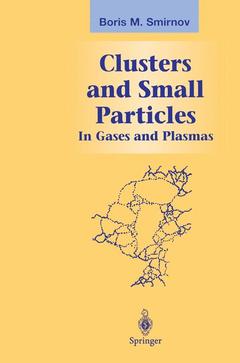Description
Clusters and Small Particles, Softcover reprint of the original 1st ed. 2000
In Gases and Plasmas
Graduate Texts in Contemporary Physics Series
Author: Smirnov Boris M.
Language: English
Subject for Clusters and Small Particles:
Clusters and Small Particles
Publication date: 10-2012
280 p. · 15.5x23.5 cm · Paperback
Publication date: 10-2012
280 p. · 15.5x23.5 cm · Paperback
Clusters & small particles
Publication date: 06-2000
280 p. · 15.5x23.5 cm · Hardback
Publication date: 06-2000
280 p. · 15.5x23.5 cm · Hardback
Description
/li>Contents
/li>
Small particles in gaseous systems are called clusters, aerosols, dust particles, Aitken particles, etc., depending on their size, the media where they are observed, and the field of science in which they are studied. Below we call clusters systems of bound atoms or molecules containing from several atoms (molecules) up to thousands, so that their structure can be essential for determining their properties. If clusters are like bulk systems, we call them small particles. The principal pecu liarity of clusters is with respect to magic numbers of cluster atoms that correspond to a heightened cluster stability. Magic numbers correspond to complete structures of clusters as systems of bound atoms or molecules. The values of magic nwnbers depend on the character of interaction of the cluster's atoms. Cluster parameters as a function of the number of cluster atoms n have extrema at the magic nwnbers of atoms. For example, a cluster with a magic nwnber of atoms has a higher binding energy and ionization potential than clusters with neighboring nwnbers of atoms. The difference between clusters and small particles is such that parameters of small particles are monotonic functions of the nwnber of their atoms, while for clusters these parameters have local extrema at magic nwnbers of atoms.
1 Behavior of Small Particles in Gases and Plasmasy.- 1.1 Collisional Processes Involving Clusters.- 1.2 Motion of Small Particles in Gases.- 1.3 Charging of Small Particles in Plasma.- 1.4 Chemical Processes Involving Clusters and Small Particles.- 2 Interaction of Small Particles with Electric and Electromagnetic Fields.- 2.1 Electric Properties of Small Particles.- 2.2 Ionization Equilibrium in Plasma Involving Small Particles and Clusters.- 2.3 Clusters and Small Particles in Radiative Processes.- 3 Bulk Systems of Bound Atoms with Pair Interaction.- 3.1 Condensed Systems of Atoms with Pair Interaction.- 3.2 Regular Crystalline Particles of Fcc-structure.- 4 Clusters with Pair Interaction of Atoms.- 4.1 Regular Clusters of Close Packed Structures.- 4.2 Icosahedral Structure of Clusters.- 4.3 Competition of Cluster Structures.- 5 Processes and Kinetics of Cluster Growth and Decay.- 5.1 Processes of Growth and Evaporation of Clusters in Parent Gas.- 5.2 Kinetics of Cluster Evolution in Parent Gas.- 5.3 Processes of Association of Two Small Particles.- 5.4 Kinetics of Association of Small Particles.- 5.5 Growth Processes in Gases Involving Fractal Systems.- 6 Clusters at Nonzero Temperature.- 6.1 Excited Clusters.- 6.2 Transitions from Clusters to Bulk Particles.- 6.3 Phase Transitions in Bulk and Clusters.- 7 Plasma with Small Particles or Clusters.- 7.1 Small Particles in Gas Discharge Plasma.- 7.2 Aerosol Plasma.- 7.3 Structures of Small Particles in Dusty Plasma.- 7.4 Charged Clusters in Arc Plasma.- Conclusion.- A Physical Parameters and Data.- A.1 Physical Constants and Relations.- A.2 Atomic Parameters.- A.3 Gaseous Values.- A.4 Parameters of Condensed Systems.- B Mechanical and Electrical Parameters of Particles Ellipsoidal and Close Forms.- B.1 The Effective Hydrodynamic Radius.- B.3 Polarizability.- C.- C.1 Models of Clusters and Small Particles.- References.
© 2024 LAVOISIER S.A.S.
These books may interest you

Gas-Phase Photoprocesses 147.69 €



